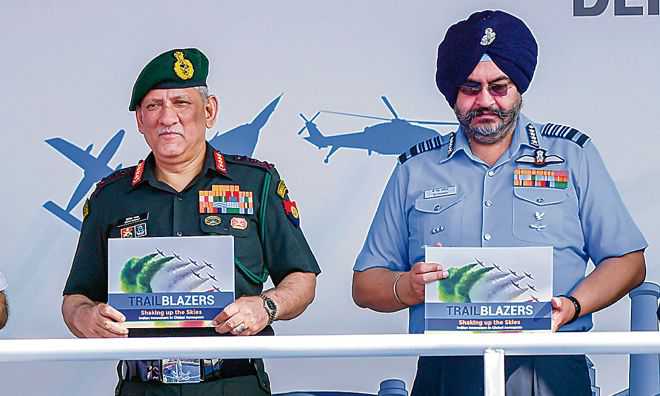
MANDATE: It has been left to the Army, led by Gen Bipin Rawat (left), to take action in the wake of the February 14 Pulwama attack.
Maj Gen Ashok Mehta (Retd)
Former GOC, IPKF, Sri Lanka
THE Army Chief, Gen Bipin Rawat, holds the key to dousing the fire raging in the hearts of the people of India following the Pulwama attack. PM Modi has ‘outsourced’ devising the contours of retribution — the time and place for its execution — to the Army. After the 2016 Uri attack, a similar standard operating procedure was followed after meetings of the Cabinet Committee on Security. Make no mistake, not retaliating is not an option, especially during election time. Given the rich electoral harvest reaped from the 2016 surgical strikes — which Pakistan denied, thereby exonerating itself of a riposte — a retaliatory strike is inevitable.
The directive to Rawat has certain parameters. That it has been left to the Army ‘to exact a heavy price’ suggests it is a single-service operation. The preconditions of the 2016 surgical strikes, as set by Modi, were: (a) that the troops would return before the first light of dawn, meaning that the incursions would be shallow; (b) No casualties; (c) No escalation. The multiple raids incorrectly called surgical strikes — a term used for aerial or nuclear targeting — were to take out terrorist launch pads, not strike Pakistan army posts that facilitate infiltration and exfiltration of terrorist groups. After the successful action, Lt Gen Ranbir Singh, then Director General of Military Operations (DGMO) and now Northern Army Commander, under whose territorial jurisdiction almost all of J&K falls, announced the end of the operation — for the time being.
This time, the remit of the Army operations may not be confined to targeting terrorist launch pads as the ISI was implicitly involved in the planning and execution of the Jaish-e-Mohammed (JeM) terror strike. Further, this is the first time a classical car bomb has been employed in J&K, the previous two attempts being less sophisticated and therefore, only partially successful. Also for the first time, a local lad, Adil Ahmad Dar, from Pulwama — the hotbed of terrorism in the Valley — a fully radicalised Burhan Wani fan comprehensively trained for the operation has become the Kashmiri suicide bomber. The February 14 attack marks the return of the IED (improvised explosive device), a more deadly version of the car bomb, and the birth of a willing-to-die local jihadi.
The legitimate arena for a cross-border punitive strike has to be Bahawalpur, the Osman O Ali Madarsa, the hideout of JeM leader Masood Azhar, who is a serial offender in India. Plucking him out or assassinating him would constitute the short-term response, but the target is in south Punjab, the citadel of the Punjabi-predominant Pakistan army. And in all likelihood, by now he is under the wings of the diabolical ISI (or in hospital, according to some reports). Any retributive strike across the International Border will attract an escalatory retaliation, and in any case, is beyond the capacity and capability of the Indian military (Indian covert capability was carelessly dismantled in 1997). This ambitious and desirable option, mirroring the taking out of Osama bin Laden from Abbottabad, can be ruled out.
Given the capability limitations of the Special Forces and the military response necessarily circumscribed by escalation domination — war not being an option — the theatre of operations gets restricted to PoK. Air strikes, being highly escalatory, are also not on the cards. It is the Special Forces alone which can take action. It is instructive to recall that following the 2001 JeM attack on Parliament, during the NDA’s rule, India’s full-scale one-year-long mobilisation was soberly called the war that never was after Pakistan lowered its nuclear threshold. In 2008, after the Mumbai attacks, the UPA government admitted that it was bereft of military options as according to then National Security Adviser (NSA) MK Narayanan, the military did not have any capability for worthwhile missions and therefore let a response pass. It was not until Uri that the NDA government carried out the highly publicised surgical strikes, surprising Pakistan.
In all these major attacks, the design of the spoilers was to prevent the fruition of back-channel talks like the four-point Kashmir formula; resumption of structured India-Pakistan dialogue; and normalisation of bilateral relations. The Pulwama attack was executed presumably to kill any chance of dialogue sought by Pakistan after the elections in India. Pakistan has raised the bar by employing a local suicide bomber. Retribution will unfold in two parts: eliminating the on-site plotters of the Pulwama attack and avenging the convoy bombing by exacting a heavy price.
Within 100 hours of the attack, the JeM leadership responsible for it was eliminated. The cross-LoC military response will be constrained by snowy conditions north of the Pir Panjal restricting the area of operations to the south of it. If Rawat can pull off surgical strike 2.0 — which visibly, credibly and proportionately avenges the Pulwama massacre — preferably before February 25, the day Modi is to inaugurate the long-awaited National War Memorial (now renamed Rashtriya Sainik Smarak, near India Gate), it will boost the NDA’s prospects of a second term. More importantly, it will lift the morale of an anguished nation but postpone ending the menace of the proxy war to another day. For the present, winning the elections is more important.



























